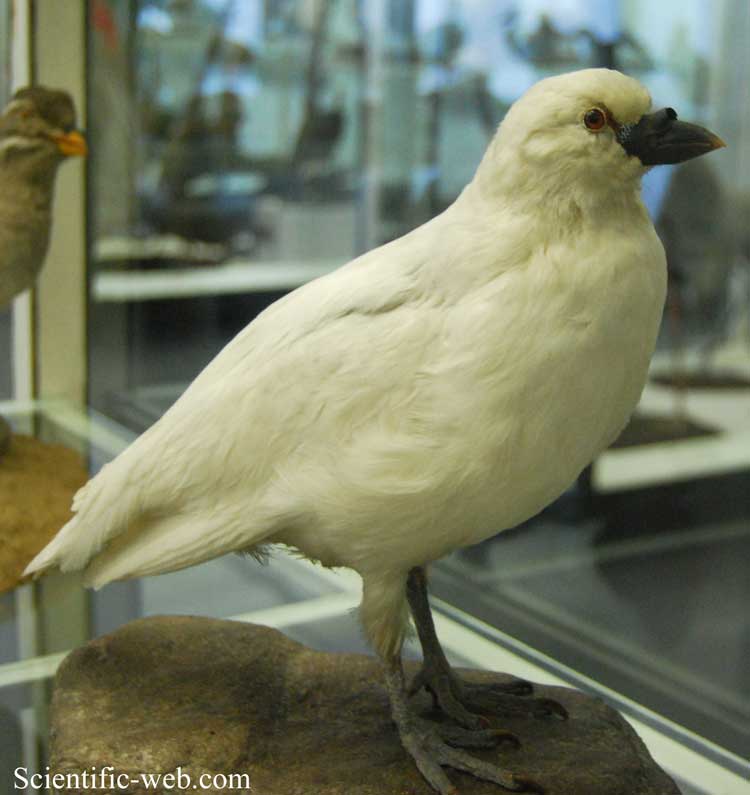
Chionis minor, Photo: Michael Lahanas
Superregnum: Eukaryota
Regnum: Animalia
Subregnum: Eumetazoa
Cladus: Bilateria
Cladus: Nephrozoa
Superphylum: Deuterostomia
Phylum: Chordata
Cladus: Craniata
Subphylum: Vertebrata
Infraphylum: Gnathostomata
Superclassis: Tetrapoda
Cladus: Reptiliomorpha
Cladus: Amniota
Classis: Reptilia
Cladus: Eureptilia
Cladus: Romeriida
Subclassis: Diapsida
Cladus: Sauria
Infraclassis: Archosauromorpha
Cladus: Crurotarsi
Divisio: Archosauria
Subsectio: Ornithodira
Subtaxon: Dinosauromorpha
Cladus: Dinosauria
Ordo: Saurischia
Cladus: Eusaurischia
Cladus: Theropoda
Cladus: Neotheropoda
Infraclassis: Aves
Cladus: Euavialae
Cladus: Avebrevicauda
Cladus: Pygostylia
Cladus: Ornithothoraces
Cladus: Euornithes
Cladus: Ornithuromorpha
Cladus: Ornithurae
Cladus: Carinatae
Parvclassis: Neornithes
Cohors: Neognathae
Ordo: Charadriiformes
Subordo: Charadrii
Familia: Chionidae
Genus: Chionis
Species: Chionis minor
Subspecies (4): C. m. crozettensis – C. m. marionensis – C. m. minor – C. m. nasicornis
Name
Chionis minor Hartlaub, 1841
References
Revue Zoologique, par la Société Cuvierienne 4 p.5
Vernacular names
Afrikaans: Kleinpeddie
català: Colom antàrtic de bec negre
čeština: Štítonos černozobý
English: Black-faced Sheathbill
español: Picovaina de las Kerguelen
suomi: Mustatuppinokka
français: Petit Chionis
italiano: Chione minore
Nederlands: Klein ijshoen
svenska: Svartnäbbad slidnäbb
Türkçe: Küçük kıngaga
The black-faced sheathbill (Chionis minor), also known as the lesser sheathbill or paddy bird, is one of only two species of sheathbills, aberrant shorebirds which are terrestrial scavengers of subantarctic islands.
Description
They are dumpy, short-necked, pigeon-like birds with white plumage, black bills, caruncles and facial skin. This species measures 38–41 cm (15–16 in) in length, 74–79 cm (29–31 in) in wingspan and weighs 460–730 g (1.01–1.61 lb), with males being slightly larger than females.[2]
Distribution
Restricted to subantarctic islands in the southern Indian Ocean: the South African territory of the Prince Edward Islands, the French territories of the Crozet Islands and Kerguelen Islands, and the Australian territory of Heard Island. The race C. m. nasicornis is endemic to Heard Island, while the race C. m. marionesis is endemic to the Prince Edward Islands.
Habitat
Coastlines and intertidal zones of subantarctic islands, especially around seabird and seal colonies, as well as the vicinity of human habitation.
Food
Sheathbills are opportunistic omnivores, predators and scavengers, feeding on strandline debris, algae and other vegetation, as well as on invertebrates, fish, seabird eggs and chicks, seal milk, blood, placentas, carrion, faeces, rodents and human refuse.
Voice
Loud, high-pitched, strident and staccato calls.
Breeding
Egg of Chionis minor
Nests in crevices, caves and under boulders on untidy piles of vegetation and debris from seabird and seal colonies. Clutch usually 2–3 creamy-white eggs, blotched or speckled brown. Incubation period c.30 days. Young semi-precocial and nidicolous; fledging c.50 days after hatching; breeding at 3–5 years.
Conservation
At risk from scavenging toxic wastes and from introduced predators such as feral cats, but large, scattered range with no evidence of significant overall population decline leads to conservation status assessment of Least Concern.
References
BirdLife International (2016). "Chionis minor". IUCN Red List of Threatened Species. 2016: e.T22693567A93413079. doi:10.2305/IUCN.UK.2016-3.RLTS.T22693567A93413079.en. Retrieved 12 November 2021.
CRC Handbook of Avian Body Masses by John B. Dunning Jr. (Editor). CRC Press (1992), ISBN 978-0-8493-4258-5.
BirdLife International. (2006). Species factsheet: Chionis minor. Downloaded from https://www.webcitation.org/5QE8rvIqH?url=http://www.birdlife.org/ on 11 February 2007
Marchant, S.; Higgins, P.J.; & Davies, J.N. (eds). (1994). Handbook of Australian, New Zealand and Antarctic Birds. Volume 2: Raptors to Lapwings. Oxford University Press: Melbourne. ISBN 0-19-553069-1
National Photographic Index of Australian Wildlife. (1987). The Shorebirds of Australia. Angus & Robertson: Sydney. ISBN 0-207-15348-5
Retrieved from "http://en.wikipedia.org/"
All text is available under the terms of the GNU Free Documentation License

